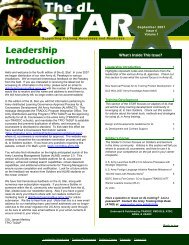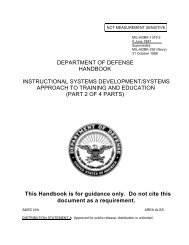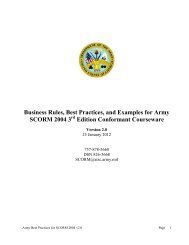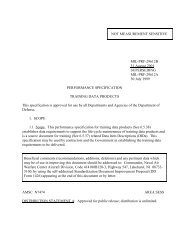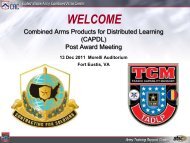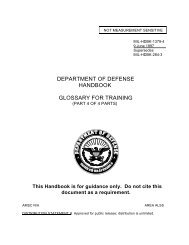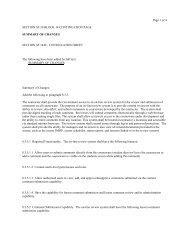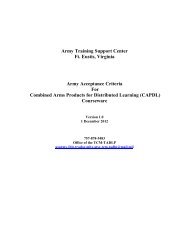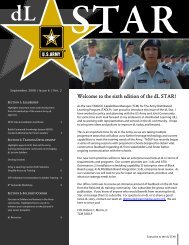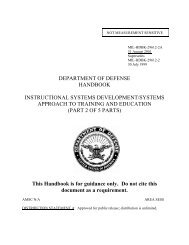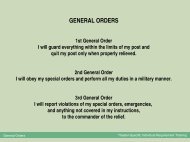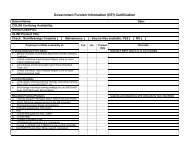dlxxi contract - U. S. Army Training Support Center
dlxxi contract - U. S. Army Training Support Center
dlxxi contract - U. S. Army Training Support Center
Create successful ePaper yourself
Turn your PDF publications into a flip-book with our unique Google optimized e-Paper software.
lesson, module (group of lessons), and course (when indicated) that provides a GO/NO<br />
GO score by lesson within that module and an overall GO/NO GO score for the module<br />
and course. The <strong>contract</strong>or shall develop sufficient test questions for every test package to<br />
provide equivalent forms of a pretest and two posttests. This can be accomplished<br />
through randomized test forms controlled by content, or through equivalent forms. This<br />
will ensure that the student has a separate evaluation for the pretest while allowing for<br />
two separate re-tests on the final test. For each test in the test package, the <strong>contract</strong>or<br />
shall provide a minimum of eight multiple-choice or short response items for each<br />
terminal learning objective that can be used with a test generation database to produce<br />
multiple forms of the evaluation.<br />
C.4.5.2 The pretest, administered before training, is an assessment that measures<br />
soldier or civilian competency on the tasks or supporting skills being trained. The pretest<br />
will be used to evaluate student ability and to use the results to improve and manage<br />
training. Providing a diagnostic pretest will allow training to be focused only on what the<br />
student needs to learn, allowing for “testing out” of lessons, modules, phases, or even<br />
the entire course. Criterion referenced performance based (multiple choice and short<br />
response) pretests will generally be designed to be administered and scored on the<br />
computer. For IMI, the <strong>contract</strong>or will design the navigation so that students will have the<br />
option to take a pretest or proceed directly to the instruction. For IMI, test results will<br />
provide immediate feedback within the context of the learning objective. Results of the<br />
pretest will also include the capability to hyperlink directly to the source material within<br />
the instruction that provides the correct answer for each question.<br />
C.4.5.3 The <strong>contract</strong>or shall develop multimedia instructional packages that include for<br />
each lesson, each module, and, when indicated, each course, a comprehensive<br />
diagnostic pretest (alternate form of posttest). A student will have the option to take a<br />
pretest or proceed directly to training. The <strong>contract</strong>or shall develop test questions to<br />
provide different versions of comprehensive posttests and a comprehensive diagnostic<br />
pretest. At least two versions of the posttest will be used to evaluate a soldier who has<br />
to retake the lesson, phase, or course so that the soldier does not take the same<br />
assessment on the retry. There shall be feedback of results and deficiencies by major<br />
learning objective (usually a lesson) and by total test, upon completion. Feedback<br />
should identify probable causes of student errors.<br />
C.4.6 Video Teletraining (VTT) Packages. The <strong>contract</strong>or shall develop or configure<br />
instruction material for use by VTT. The material includes new visuals, student materials,<br />
instructor materials, and tests.<br />
C.4.6.1 <strong>Army</strong> VTT consists of two networks: the Teletraining Network (TNET) and the<br />
Satellite Education network (SEN). TNET’s compressed digital technology delivers<br />
interactive training by broadcasting two-way audio and video via satellite and telephone<br />
lines from an instructor’s site to multiple student sites in geographically dispersed<br />
locations. SEN delivers a high quality compressed, digital signal to downlinks over a<br />
satellite for one-way video with return audio over telephone lines. TNET is located at Fort<br />
Eustis, Virginia; SEN at the <strong>Army</strong> Logistics Management College, Fort Lee, Virginia.<br />
C.4.6.2 VTT uses television networks to deliver instruction from an originating site to<br />
remote locations. Selected training sites are able to interact with the instructor, either<br />
audibly, visually or both. VTT provides the live, one-on-one, audiovisual communication



